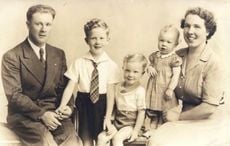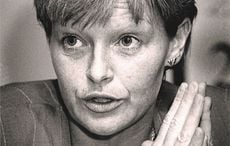| Finale of last year's Dublin Irish Festival |
We have just come through the “green season” with more parades bursting with “Irish pride” for our culture and heritage than I can reckon off the top of my head, including the very first one in Yonkers down the Irish mile chronicled on these pages last week. The amount of energy and man hours extended to make all that happen could probably run a third world country for a decade.
So why can’t we put on a decent Irish festival sometime during the year in the greater New York area that would properly reflect the vast cultural resources around us to not only inform the Irish of their roots, but a wider community about why the Irish matter around here?
What got me asking this question was a two-day conference for the 2012 North American Irish and Celtic Festival organizers conference in Dublin, Ohio where Dublin will host a 25th anniversary festival in August (www.dublinirishfestival.org).
Along with the 32-years running Milwaukee Irish Fest (www.irishfest.com) and the baby of the group, Kansas City Irish Festival (kcirishfestival.com) now in its 10th year, these three Midwestern power houses -- not the first places that come to mind amidst the Irish Diaspora -- all boast an attendance that reaches 100,000 people annually for their multi-day celebrations.
Among the 17 Irish or Celtic festivals registered for the conference (including the relatively tiny Catskills Irish Arts Week that I represented as artistic director) 11 hailed from the Midwest, and large Irish cities like New York, Boston, or San Francisco weren’t in the pool.
The conference grew out of the leadership of the Milwaukee Irish Fest team of Ed and Chuck Ward and the executive director Jane Anderson, who is stepping down this year after a two-decade reign of the huge organization populated by the largest volunteer corps (4,000) in the Irish festival scene.
Not only was it a time of steady growth and organization making Irish Fest the largest Irish festival in the world, but there was a generosity and solidarity for reaching out to other festivals in aiding and abetting their efforts to ramp up their learning curve.
Blessed with an 85-acre municipal property on the shore of Lake Michigan, the Milwaukee crew expanded its efforts to create not only a varied and creative entertainment package every year, but dedicated themselves to using every parcel of land as productively as possible to inform as well as entertain its audience.
With four days of good weather the crowd can swell to 140,000 people from all over the country in late August (August 16-19).
While music stages were filled with all the top groups in the Celtic music world over the years, very critical thinking and research resulted in some fascinating cultural themes and workshops in the larger cultural sphere being afforded space and context within the festival environs and that became a very important aspect of the Irish Fest mission every year.
For instance, way back in 1992 in one of the years that I attended, to mark the 200th anniversary of the Belfast Harp Festival in 1792, 19 harpers were brought over from Ireland for a week under the direction of Janet Harbison to perform and lecture about the role of the Irish harp in Irish history.
Over the years, Anderson encouraged other festival organizers to meet and greet over lunch on the grounds during the festival, and that social interaction led to a more formal sessions every other year in locations with other festivals like Pittsburgh and Kansas City, but also in Cape Breton and Limerick where invitations and government support were offered to bolster hiring bands from the Canadian Maritimes and Ireland.
Not only was there strength in unity, but the bonds built up by so many dedicated officers and volunteers fronting the Irish and Celtic festivals around the country brought more than just camaraderie and commiseration.
There was a work ethic that permeated the “Busman’s Holidays” aspect of these gatherings where music showcases at night provided a look at new talent options while the days were filled with topical information sessions on a host of issues involved in mounting major festivals around the country.
The host of the conference this past weekend was the City of Dublin, a suburb of Columbus, Ohio, a newly minted city (1987) in the midst of Ohio farmland that is home to 41,000 residents.
In that quarter century Dublin has mushroomed into one of the largest Irish Festivals in the world, drawing 100,000 people to its parkland grounds adjoining a very modern town recreation center and campus.
Recognizing the value of cultural entertainment to tourism, a notion which is becoming more popular in these economically challenging times as we have observed in Canada, Ireland and across the U.S., it also boosts civic and regional pride of place. And for a place like Dublin, being Irish is more of an attitude than it is a genealogical fact measured in bloodlines.
So when director of event management Alison LeRoy and her team of municipal employees oversaw the weekend activities, it was with a skill set that was well honed for dealing not only with issues pertaining to hosting Irish music events, but with the overall attention necessary for successful event management in today’s world.
And increasingly that ethos is ever present at festivals in Minnesota, Indiana, Michigan, Kansas City, Pittsburgh, Cleveland, Oshkosh and LaCrosse where inspiration crosses boundaries and competition seemingly does not because there is a very supportive alliance in place among these festival mavens.
The panoply of issues, initiatives and concerns are consensus driven by the active members of the loosely organized Conference group. Considerable time and discussion is given to improving each of the member festivals with new and different strategies readily shared by the more innovative or well-resourced festival folk.
Having attended five of these conclaves during my own tenure at the helm of the small but well-respected niche festival for traditional Irish music and dance, the Catskills Irish Arts Week, it has been eye-opening to observe the massive skills evident and practiced in the wider Irish festival scene.
Spending time with such dedicated and savvy organizers gives new meaning to the term “craic committee,” because while it is obvious they work very hard at their own festivals and in conference settings, they can play pretty hard as well and hence a esprit de corps has developed that one wishes could envelop the greater New York metropolitan area and inspire a decent festival to warrant bringing people to it.
Like any good conference, one returns with optimism and a longer to do list infused with hope and aspirations. It doesn’t take too long, though, before reality sets in and I concentrate on the agenda of maintaining the Catskills Irish Arts Week as a pre-eminent summer school and festival within its limited confines.
I will have to leave the dreaming about what could be done locally on festival development to others with more youth and time and vision. One lesson they will have to start with, however, is to get out of New York City and imagine Ireland as it is viewed from so many wonderful places around this country.




Comments